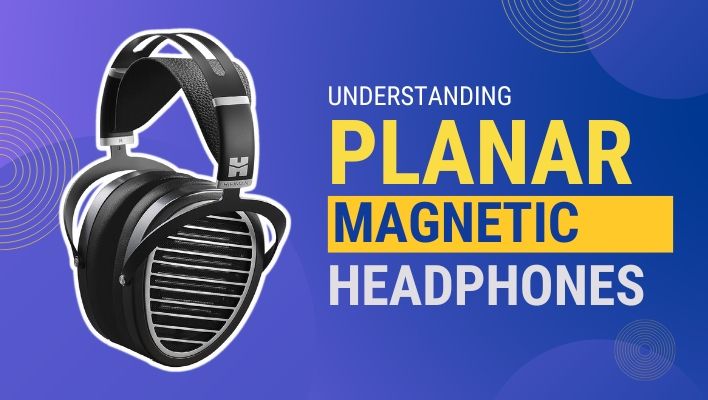When it comes to finding the best headphones, it can sometimes feel like an uphill battle. There are tons of features and specifications you need to consider, from noise cancellation capabilities to sound quality — and that’s just scratching the surface.
Perhaps two of the most confusing technical aspects when shopping for headphones are planar magnetic vs dynamic driver design. But understanding their differences doesn’t have to be a headache anymore!
In this blog post, we’ll unpack the ins and outs of these two types of headphones in order to help you make an informed decision when shopping for a new pair of headphones.
What are Planar Magnetic Headphones?
Planar Magnetic Headphones are a type of headphones that utilizes a planar magnetic driver to deliver sound. This driver consists of a thin diaphragm that is surrounded by magnets and suspended between two perforated metal plates. The diaphragm vibrates in response to the audio signal, creating sound waves which then travel to the ear.

Traditional headphones typically feature several drivers, including dynamic, electrostatic, and balanced armature drivers, that work together to generate sound. These drivers cause a large amount of soundwaves to overlap and mix, which can lead to distortion.
Planar magnetic drivers, on the other hand, use a thin diaphragm with an array of magnets attached to it that vibrate when an electrical signal is passed through it. This setup allows for a more efficient transfer of energy into sound waves and produces less interference between frequencies than traditional headphones.
As a result, planar magnetic drivers are able to produce clearer highs and mids as well as a richer bass response.
Furthermore, they offer excellent stereo imaging capabilities and provide greater overall detail in the music – making them ideal for those looking for high-fidelity audio reproduction.
The Pros and Cons of Planar Magnetic Headphones
Planar magnetic headphones offer a unique audio experience, but like all technological advances, they come with both advantages and disadvantages. In this section, we will explore the pros and cons of planar magnetic headphones, so you can make an informed decision when it comes to purchasing a pair.
Pros:
Accurate Sound Reproduction
Planar magnetic headphones have an incredibly accurate sound reproduction due to their design which utilizes a thin, flat diaphragm. This allows for greater audio clarity and a more natural sound.
Additionally, the drivers used in planar magnetic headphones are able to move large amounts of air quickly without distortion. This ensures that the sound is clear and accurate across the frequency spectrum.
Durability
Another benefit of planar magnetic headphones is that they are generally more durable. This is because the magnets used to create the sound are larger and more robust.
The strong magnets used in these headphones ensure that no matter how hard you use them, they will still last for a long time.
Cons:
Cost
Planar magnetic headphones tend to be more expensive than other types of headphones. This is due to the advanced technology used to produce them and the additional manufacturing costs accrued to make them sturdy enough for everyday use.
Furthermore, some models may require dedicated headphones amplifiers, which further increase the cost of ownership.
Bulkiness
Because of the large magnets used in planar magnetic driver designs, these headphones tend to be bulky and heavy compared to other types of headphone designs. This can make them difficult or uncomfortable to wear for extended periods of time.
Limited Range
While planar magnetic headphones offer excellent audio clarity, there is a limit on how well they can perform at higher frequencies as compared to other types of headphone designs.

What are Dynamic Headphones?
Dynamic headphones use dynamic drivers to produce sound. This type of driver works by using an electromagnet to move the diaphragm back and forth, which creates sound waves.
The diaphragm is made from either a thin plastic, paper, or metal material, and is suspended in a magnetic field generated by the electromagnet. When an audio signal is sent to the headphones, the electromagnet causes the diaphragm to move back and forth, creating sound waves that travel through the earphone and into the ear.
Dynamic headphones are known for their robust and powerful sound, with a wide frequency response range. Furthermore, they are typically more durable and require less power to operate, making them a popular choice for portable audio devices.
The Pros and Cons of Dynamic Headphones
Pros:
Comfort
Dynamic headphones are usually well padded, providing long-lasting comfort even when worn for long periods of time. Additionally, their lightweight design means they won’t cause discomfort or fatigue like heavier models can.
Durability
Dynamic headphones are generally considered to be extremely durable and often have a long life span. They are built with premium materials, designed for maximum reliability, and can withstand the rigors of everyday use.
The ear cups and headband are usually made from tough plastic and vinyl, while the wires, drivers, and other components are assembled with tight tolerances to ensure that they can stand up to wear and tear.
Additionally, dynamic headphones generally come with replaceable parts, like ear pads or cable assemblies, which can be easily swapped out should any part fail.
With proper care and maintenance, dynamic headphones can last for years without needing major repairs or replacements.
Cons:
Distortion At High Volumes
Because of the way the drivers are built, dynamic headphones distort slightly more at high volumes. They also lack planar headphones’ somewhat more immersive sound quality.

Dynamic Vs Planar Magnetic Headphones
Dynamic and planar magnetic headphones both have strengths and weaknesses in sound quality, comfort, and design appeal. It’s hard to say one is better than the other without considering how they fit the user’s needs and preferences in audio reproduction, practicality, and ergonomics.
Driver Design
Dynamic drivers are renowned for their straightforward setup. A magnetic field is generated in the voice coil, attached to the diaphragm, through a small current from the audio source. When this coil is electrically charged, it is drawn to the permanent magnet, resulting in the diaphragm vibrating and emitting sound waves.
Planar magnetic drivers also use electrical impulses sent to a conductive material, or “windings”, with two permanent magnets. The windings are dispersed over the diaphragm’s thin membrane, which vibrates as a result of the electrical signals.
Unfortunately, this necessitates that the magnets be large enough to cover the conductive material’s surface area, making planar magnetic headphones slightly heavier and bigger than dynamic ones and consuming more power.
Bass Response
The difference between bass response from planar and dynamic headphones is significant.
Planar headphones are generally considered to be more accurate in terms of bass reproduction, mainly because they use a thin, flat diaphragm that creates a uniform sound field. This ensures that low frequencies are reproduced with high fidelity which results in tighter bass with superior control and definition. In addition, planar drivers are magnetically driven as opposed to dynamic drivers which use voice coils, resulting in more efficient movements of the diaphragm which allows for better impulse response and greater accuracy in transient detail.
Dynamic headphones use a large speaker-style driver with heavier moving parts which can cause distorted sound due to the limited excursion of the diaphragm. As such dynamic headphones often produce muddy sounding bass with less detail and depth. It’s also worth noting that some dynamic headphones employ multiple small drivers within the same enclosure to create a larger sound field with enhanced bass control and impact. However, this ‘multi-driver’ approach does come at an increased cost compared to single driver designs as well as introducing several other sonic issues such as phase distortion, frequency masking and comb filtering.
Soundstage
The soundstage is the perceived soundscape created by headphones, and it often differs between planar and dynamic models.
Planar headphones are designed to provide a wide and immersive soundstage because of their larger diaphragm area and low impedance, which allows them to deliver a large quantity of air.
The larger diaphragm area also allows planars to reproduce more detail in all frequency ranges; this creates a sense of space that can make the listener feel as if they’re surrounded by multiple instruments playing at once.
Dynamic headphones typically feature smaller drivers, meaning their soundstage tends to be narrower. The drivers also tend to have higher impedance, making the sounds seem more compressed than those from planar headphones. Additionally, the dynamic driver’s size makes them less efficient at reproducing subtle details in music, resulting in a smaller sense of space for the listener.
Conclusion
In conclusion, dynamic and planar magnetic headphones offer a range of listening experiences. Dynamic headphones are more accessible and easier to manufacture, making them an ideal option for casual or budget-conscious listeners. They also come in a variety of sound profiles, however they are prone to distortion at higher volumes.
On the other hand, planar magnetic headphones are more complex and costly to make, making them best suited for critical listeners. They provide a more accurate and immersive sound, and feature less distortion at high volumes, but are bulkier.
Ultimately, the decision of which type of headphones to purchase depends on the individual’s preferences and budget.


Thank you for another wonderful post. Where else may just anyone get that kind of info in such a perfect method of writing? I’ve a presentation subsequent week, and I’m at the look for such info.